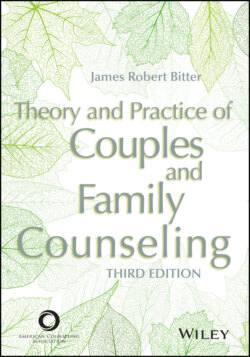Читать книгу Theory and Practice of Couples and Family Counseling - James Robert Bitter - Страница 104
Conceptualizing the Client
ОглавлениеIf your practice consists solely of individual clients, the definition of client is clear: It is the person sitting across from you in a counseling or therapy session. The more systemically oriented counselors, however, embrace the family as a whole as the client—with many, like Whitaker, insisting that all members of the family be present before therapy begins. The first practitioners of Bowen family therapy, structural family therapy, and the various strategic therapies emphasized family dynamics in which individuals were little more than parts of an interaction or actors in a systemic drama. In the past decade, there has been a concerted effort to reinstate the individual into family systems theories, with postmodern models tending to conceptualize families and clients as those individuals who are in conversation about any given problem. In these later models, those in conversation about a problem determine who needs to be involved in family sessions.3 What happens to confidentiality in these shifting conceptualizations of family is at the heart of one whole set of ethical concerns. Even within systemic orientations, there are those who choose to approach families not as one client but as multiple clients, a perspective that is assumed in most state laws.
Remley and Herlihy (2020) indicated that laws hold individuals, not the collection of people called a family, accountable for actions that may violate the freedom of others. This should not be surprising in a society that values individualism over collectivism. But it also has a similar impact on the more practical standards of practice involved in professional codes.
A clear example relates to the use of case notes in family practice. If the client is the family, there is one client. It is logical then that the family practitioner would write one set of case notes for the one client. But this is not necessarily so: IAMFC (2017), for example, suggests that “in situations involving multiple clients, couple and family counselors provide only the records directly related to a particular individual, protecting confidential information related to any other client” (p. 4). In both the law and this professional code, one family of five equals five individuals. To meet HIPAA standards, each individual has to have their own records, notes, consent, and other individual data. Having multiple clients in counseling or therapy thus has a direct impact on informed consent.
